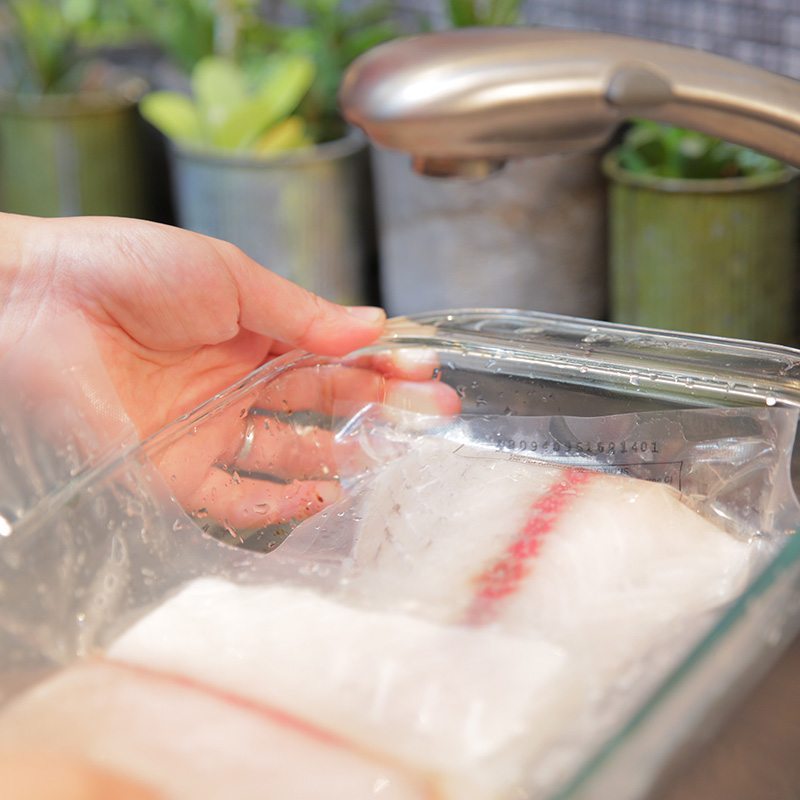There are a few different methods you can use to thaw frozen fish:
1. Refrigerator Method: Place the frozen fish in a sealed container or plastic bag and defrost it in the refrigerator. This method will take the longest, usually around 24 hours, but it is the safest way to thaw fish as it minimizes the risk of bacterial growth.
2. Cold Water Method: Place the frozen fish in a sealed plastic bag and submerge it in cold water. Change the water every 30 minutes to ensure it stays cold. This method can take around 1-2 hours depending on the thickness of the fish.
3. Microwave Method: Use the defrost setting on your microwave to thaw the fish. Be cautious to follow the manufacturer’s instructions, as microwave power levels may vary. This method requires careful monitoring to prevent overcooking or partially cooking the fish.
4. Cooking from Frozen: If you’re in a hurry, you can also cook frozen fish without thawing it. Simply increase the cooking time by about 50% and carefully monitor the internal temperature of the fish to ensure it is cooked thoroughly.
Remember to always follow proper food safety guidelines when thawing fish to avoid the risk of foodborne illnesses.
Know More About: how to thaw frozen fish
Thawing Frozen Fish: A Guide to Restoring Taste and Texture
Introduction:
Frozen fish, a convenient option for many home cooks, has become increasingly popular due to its long shelf life and ease of preparation. However, proper thawing techniques are essential to maintain the quality and integrity of the fish. In this guide, we will explore the best methods for safely and effectively thawing frozen fish, ensuring that it retains its delicious taste and delicate texture.
1. Plan Ahead:
Before you embark on thawing frozen fish, it is important to plan ahead and allow enough time for the process. This prevents the need for rushed methods that might compromise the fish’s quality. Always take into consideration the amount of time required for thawing, especially if you have a specific recipe in mind.
2. Refrigerator Thawing:
The refrigerator method is the most recommended way to thaw frozen fish as it maintains a consistent, cool temperature, allowing the fish to defrost slowly and safely. To proceed, place the fish in its original packaging or a leak-proof bag and set it on a plate or shallow tray to catch any residual liquid. Leave it in the refrigerator for approximately 24 hours or overnight.
3. Cold Water Bath:
When time is of the essence, the cold water bath method is a reliable alternative. Fill a large bowl or sink with cold water, ensuring the fish is fully submerged. Place the fish in a sealed plastic bag to prevent water absorption. Replace the water every 30 minutes to maintain a consistently low temperature. Thawing time typically varies, but this method can take roughly one to two hours depending on the size and thickness of the fish.
4. Defrosting in the Microwave:
If immediate use is necessary, the microwave may come to your rescue. However, it is important to note that this method should be your last resort due to potential texture changes and uneven defrosting. Before starting, remove any metal or plastic packaging and place the fish on a microwave-safe plate. Select the defrost function or use 30% power, setting the timer in shorter intervals to prevent premature cooking. Always remember to cook the fish immediately after thawing in the microwave.
5. Quick Tip: Cooking from Frozen:
Cooking from frozen is another option when you’re short on time. However, it is essential to purchase fish that is specifically labeled as safe for cooking from frozen. With this method, the fish goes straight from the freezer to the pot or oven, reducing thawing time altogether. While this may be convenient, it is important to note that cooking times will be longer compared to thawed fish.
Conclusion:
Thawing frozen fish doesn’t have to be a daunting task; by following these methods, you can ensure that your fish maintains its delicious taste and delicate texture throughout the preparation process. Remember to plan ahead, opting for refrigerator thawing whenever possible for optimal results. If you find yourself in a time crunch, the cold water bath or microwave methods can be effective alternatives. Additionally, cooking fish from frozen can save time, but make sure the packaging indicates the fish is safe for this method. With these techniques under your belt, you’ll never have to worry about thawing frozen fish again, allowing you to enjoy the full flavor of this versatile ingredient in your favorite dishes.
FAQs on how to thaw frozen fish
1. How long does it take to thaw frozen fish?
Typically, it takes 24 hours in the refrigerator for frozen fish to thaw completely.
2. Can I thaw frozen fish quickly using hot water?
While you can use hot water to thaw fish, it is not recommended as it can cause the fish to thaw unevenly and potentially introduce harmful bacteria. It is best to use the refrigerator for a slow and safe thaw.
3. Is it safe to thaw frozen fish on the kitchen counter?
No, thawing frozen fish at room temperature is not advisable, as it promotes bacterial growth. It is vital to thaw fish in the refrigerator or using cold water.
4. How long can I keep thawed fish in the refrigerator before cooking it?
After thawing the fish in the refrigerator, it is best to cook it within 24 hours to maintain its quality and freshness.
5. Can I cook frozen fish without thawing it?
Yes, you can cook fish directly from frozen, but it may take longer to cook through completely. Adjust cooking times accordingly and ensure the fish reaches an internal temperature of 145°F (63°C) for safe consumption.
6. Can I thaw frozen fish in the microwave?
While it is possible to thaw fish in the microwave, it is not recommended due to the risk of uneven thawing and potential partial cooking. If using the microwave, use the defrost function at a low power setting and check the fish frequently.
7. How can I thaw fish quickly using cold water?
To thaw fish quickly in cold water, place the frozen fish in an airtight plastic bag and submerge it in a bowl of cold water. Change the water every 30 minutes until the fish is thawed, which can typically take about 1-2 hours.
8. Can I refreeze fish that has been thawed?
It is generally safe to refreeze fish that has been thawed, but the quality and texture may be compromised. It is best to cook the fish after thawing rather than refreezing it.
9. Is it necessary to remove the packaging before thawing frozen fish?
It depends on the packaging. If the fish is vacuum-sealed, it is recommended to thaw it while still in the packaging to preserve its quality. However, if the packaging is not airtight, it is advised to remove it to avoid any potential contamination.
10. How can I speed up the thawing process if I forgot to take the fish out of the freezer in advance?
If you need to speed up the thawing process, you can seal the fish in a waterproof bag and place it under cold running water. This helps accelerate the thawing process but requires constant monitoring to prevent the fish from reaching an unsafe temperature.

